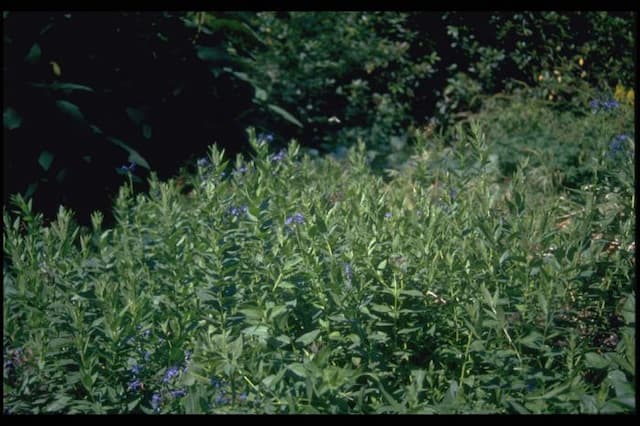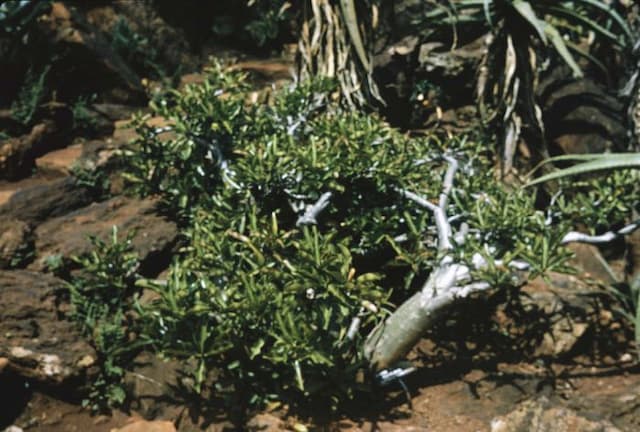Mandevilla Mandevilla Sundaville Cream Pink = 'Sunparapibra' (PBR) (Sundaville Series)

ABOUT
The Mandevilla Sundaville Cream Pink is recognized primarily for its stunning blooms that present a delicate cream pink color, drawing immediate attention in any garden setting. The blossoms exhibit a distinct trumpet shape, which adds a touch of exotic flair and visual intrigue. These flowers contrast vividly against the plant's verdant foliage, which boasts glossy, lance-shaped leaves that provide a lush backdrop to the showy floral display. This Mandevilla is known for its vigorous growth and can support numerous blooms, creating a cascade of color that remains visually captivating throughout its blooming season. The creamy pink petals emphasize a soft and romantic appearance, making this variety a popular choice for adding a soothing yet elegant touch to outdoor spaces.
About this plant
 Names
NamesSynonyms
Rocktrumpet, Sundaville Pink, Dipladenia, Brazilian Jasmine
Common names
Mandevilla 'Sunparapibra', Dipladenia 'Sunparapibra'.
 Toxicity
ToxicityTo humans
Mandevilla plants can be toxic if ingested by humans. While the level of toxicity can vary, they contain compounds that can cause gastrointestinal upset such as nausea, vomiting, and diarrhea if parts of the plant are consumed. Additionally, the sap can be irritating to the skin and eyes upon contact. Ingesting parts of the Mandevilla plant can potentially lead to more serious symptoms depending on the amount consumed; therefore, it is advisable to keep the plant out of reach of small children who might accidentally ingest it.
To pets
Mandevilla plants are also toxic to pets. If a cat or dog ingests part of a Mandevilla plant, they may experience symptoms such as vomiting, drooling, diarrhea, and abdominal pain. More severe reactions can occur depending on the quantity ingested and can include heart rhythm abnormalities and seizures in rare cases. Owners should ensure pets do not have access to Mandevillas, and if ingestion occurs, it is important to seek veterinary attention immediately.
 Characteristics
CharacteristicsLife cycle
Perennials
Foliage type
Evergreen
Color of leaves
Green
Flower color
Cream Pink
Height
6-10 feet (1.8-3 meters)
Spread
2-3 feet (0.6-0.9 meters)
Plant type
Climber
Hardiness zones
9
Native area
South America
Benefits
 General Benefits
General Benefits- Attractive Flowers: Mandevilla Sundaville Cream Pink produces beautiful creamy pink flowers that add aesthetic appeal to gardens and landscapes.
- Long Blooming: The plant is known for its long blooming season, providing color and interest for much of the year.
- Climbing Growth Habit: It has a climbing habit which makes it perfect for growing on trellises, fences, and pergolas, adding vertical interest to garden spaces.
- Low Maintenance: Mandevilla Sundaville Cream Pink is relatively easy to care for, requiring minimal maintenance once established.
- Drought Tolerant: Once established, the plant is quite drought tolerant, making it suitable for warm climates and water-conserving gardens.
- Heat Tolerant: It can thrive in hot conditions, making it an ideal choice for gardens in warmer regions.
- Rapid Growth: The plant grows quickly, providing fast coverage for garden structures or bare spots in the landscape.
- Attracts Pollinators: Its vibrant flowers can attract beneficial pollinators like butterflies and hummingbirds to the garden.
 Medical Properties
Medical PropertiesThis plant is not used for medical purposes.
 Air-purifying Qualities
Air-purifying QualitiesThis plant is not specifically known for air purifying qualities.
 Other Uses
Other Uses- Container Gardening: Mandevilla is well-suited for use in container gardens, where its trailing vines can be draped over the edges to create a lush and vibrant display.
- Vertical Accents: Because of its climbing nature, the plant can be used to add vertical interest to a garden, trained up trellises, arbors, or pergolas.
- Interior Decoration: When kept in a bright indoor space, Mandevilla can serve as a decorative houseplant, adding color and life to interior environments.
- Temporary Ground Cover: Where permitted to sprawl, the Mandevilla can form a temporary ground cover, filling in gaps with its attractive foliage and blooms.
- Wedding Decor: The elegant flowers can be incorporated into wedding decor, used in creating floral arches, table centerpieces, or as a delicate backdrop.
- Photography Prop: Mandevilla plants can serve as a charming backdrop for photography, perfect for garden-themed photo shoots and portraits.
- Bonsai Art: Some gardeners may use Mandevilla for bonsai, training the vine to grow within a small, controlled shape to create living art.
- Scented Garden: Mandevilla flowers can contribute to a scented garden, offering a light fragrance to the blend of aromatic plants.
- Holiday Arrangements: The blooms and foliage can be used in holiday arrangements or wreaths, especially in regions where they bloom during festive seasons.
- Playground Decoration: When safely installed and maintained, the vibrant colors and shapes of Mandevilla can liven up children's play areas.
Interesting Facts
 Feng Shui
Feng ShuiThe Mandevilla is not used in Feng Shui practice.
 Zodiac Sign Compitability
Zodiac Sign CompitabilityThe Mandevilla is not used in astrology practice.
 Plant Symbolism
Plant Symbolism- Charm and Grace: The elegant Mandevilla, with its twining vines and trumpet-shaped flowers, often symbolizes charm and grace due to its delicate and refined appearance.
- Passion: The vibrant and colorful flowers can represent passionate feelings, whether it's in love, art, or any other passionate pursuit.
- Beauty: With its stunning blooms, the Mandevilla plant is commonly associated with beauty and loveliness.
- Warmth: Because Mandevilla thrives in warm climates, it is sometimes used to symbolize the warmth of emotion or a warm personality.
- Hospitality: The plant's welcoming appearance might be used to symbolize hospitality and the friendly reception and treatment of guests.
 Water
WaterMandevillas, including Sundaville Cream Pink, prefer consistently moist soil, but they do not like to be waterlogged. Water the plant thoroughly whenever the top inch of soil feels dry to the touch, which typically means once a week. During hot, dry periods, you may need to water twice a week, providing about 1-2 gallons depending on the size of the plant and pot. Decrease watering frequency in the winter months when the plant is not actively growing. Over-watering can lead to root rot, so ensure proper drainage.
 Light
LightSundaville Cream Pink mandevillas thrive in bright, indirect sunlight. They perform best when placed in a location that receives morning sun and afternoon shade, or a spot with filtered sunlight throughout the day. Direct, intense midday sun can scorch the leaves, so providing some protection during the hottest part of the day is beneficial.
 Temperature
TemperatureThe Sundaville Cream Pink mandevilla prefers warm temperatures, thriving in conditions between 60°F and 70°F. It can survive minimum temperatures of around 50°F but should be protected from frost, as temperatures below 50°F can be damaging. Ideally, maintain a daytime temperature around 70°F for optimal growth.
 Pruning
PruningPrune your Sundaville Cream Pink mandevilla to maintain its shape and encourage bushier, more vigorous growth. Pruning is best done in early spring before new growth begins. Snip off any dead or damaged stems, and trim back overgrown areas to keep the plant tidy. Also, pinch back stem tips to promote branching. Pruning every year helps improve air circulation and enhances the plant's overall health.
 Cleaning
CleaningAs needed
 Soil
SoilThe best soil mix for Mandevilla is a well-draining potting mix with peat, perlite, and pine bark. A slightly acidic to neutral pH of 5.5 to 7.0 is ideal for healthy growth.
 Repotting
RepottingMandevilla should be repotted every 2-3 years or when it becomes root-bound to ensure continued health and growth.
 Humidity & Misting
Humidity & MistingMandevilla thrives in moderate to high humidity levels, between 50% and 70%, which encourages lush growth and vibrant blooming.
 Suitable locations
Suitable locationsIndoor
Place Mandevilla in bright indirect light, away from drafts and dry air.
Outdoor
Grow Mandevilla in a sunny spot with some afternoon shade and shelter.
Hardiness zone
9-11 USDA
 Life cycle
Life cycleMandevilla 'Sunparapibra', commonly known as Sundaville Cream Pink, begins its life cycle with seed germination, which takes place in warm conditions with plenty of light. After germination, the seedling stage involves developing true leaves and establishing a root system. As it matures into the vegetative stage, the plant exhibits rapid foliage growth and vine elongation, preparing for flowering. During the flowering stage, Sundaville Cream Pink produces delicate cream-pink blooms that attract pollinators and add ornamental value. Following pollination, the plant may produce seed pods, completing its reproductive cycle. In perennial growing zones, the plant goes into dormancy during colder months, reducing growth until favorable conditions return; in other zones, it is grown as an annual and would complete its life cycle within a single growing season.
 Propogation
PropogationPropogation time
Spring-Early Summer
Propogation: The most popular method to propagate the Mandevilla, also known as the Mandevilla Sundaville Cream Pink, is through stem cuttings. This is typically done in spring or early summer when the plant is actively growing. To propagate, a gardener would take a cutting of about 4 to 6 inches (10 to 15 cm) from a healthy stem just below a leaf node. The leaves near the bottom of the cutting should be removed, and the cut end may be dipped in rooting hormone powder to encourage root growth. The cutting should then be placed in a well-draining potting mixture and kept moist and warm, around 75 degrees Fahrenheit (24 degrees Celsius), with indirect sunlight. Roots usually develop within a few weeks, after which the cutting can be treated as a new plant.



![Star jasmine [Star of Toscana]](/_next/image?url=https%3A%2F%2Fplants-admin.emdemapps.com%2Fimages%2Fplants%2F%2Fimages%2F604b62fa574d4.png&w=640&q=75)





